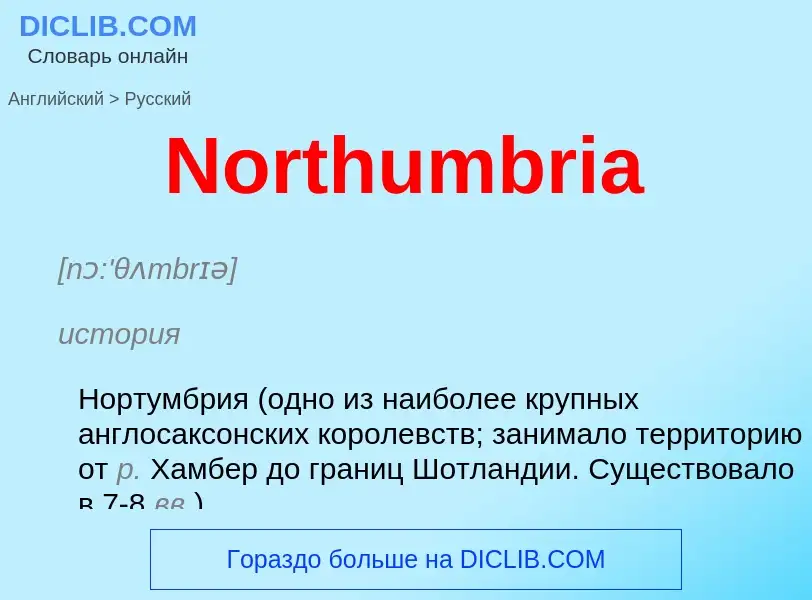Traducción y análisis de palabras por inteligencia artificial
En esta página puede obtener un análisis detallado de una palabra o frase, producido utilizando la mejor tecnología de inteligencia artificial hasta la fecha:
- cómo se usa la palabra
- frecuencia de uso
- se utiliza con más frecuencia en el habla oral o escrita
- opciones de traducción
- ejemplos de uso (varias frases con traducción)
- etimología
Northumbria - traducción al ruso
[nɔ:'θʌmbrɪə]
история
Нортумбрия (одно из наиболее крупных англосаксонских королевств; занимало территорию от р. Хамбер до границ Шотландии. Существовало в 7-8 вв.)
устаревшее выражение
Нортумбрия (графство Нортамберленд)
синоним
['æŋglz]
история
англы (древнегерманское племя. В 5-6 вв. англы участвовали в англосаксонском завоевании Британии [Britannia], где позднее образовали несколько королевств, в т.ч. Мерсию [Mercia], Восточную Англию [East Anglia] и Нортумбрию [Northumbria]; по их имени часть Британии стала называться Англией [Anglia])
синоним
существительное
история
англы
[,praɪmɪtəv'ɪŋglənd]
общая лексика
примас Англии (титул архиепископа Йоркского [Archbishop of York])
Wikipedia
Northumbria (; Old English: Norþanhymbra rīċe; Latin: Regnum Northanhymbrorum) was an early medieval Anglo-Saxon kingdom in what is now Northern England and south-east Scotland.
The name derives from the Old English Norþanhymbre meaning "the people or province north of the Humber", as opposed to the people south of the Humber Estuary. Northumbria started to consolidate into one kingdom in the early seventh century, when the two earlier core territories of Deira and Bernicia entered into a dynastic union. At its height, the kingdom extended from the Humber, Peak District and the River Mersey on the south to the Firth of Forth (now in Scotland) on the north. Northumbria ceased to be an independent kingdom in the mid-tenth century when Deira was conquered by the Danes and formed into the Kingdom of York. The rump Earldom of Bamburgh maintained control of Bernicia for a period of time; however, the area north of the Tweed was eventually absorbed into the medieval Kingdom of Scotland while the portion south of the Tweed was absorbed into the Kingdom of England and formed into the county of Northumberland and County Palatine of Durham.



![800}}, showing the lavishly decorated text that opens the [[Gospel of John]] 800}}, showing the lavishly decorated text that opens the [[Gospel of John]]](https://commons.wikimedia.org/wiki/Special:FilePath/KellsFol292rIncipJohn.jpg?width=200)

![Sword pommel from the [[Bedale Hoard]], inlaid with gold foil. Sword pommel from the [[Bedale Hoard]], inlaid with gold foil.](https://commons.wikimedia.org/wiki/Special:FilePath/Sword Pommel from the Bedale Hoard YORYM 2014 149 1-1.jpg?width=200)
![Suevian peoples]] in red, and other [[Irminones]] in purple Suevian peoples]] in red, and other [[Irminones]] in purple](https://commons.wikimedia.org/wiki/Special:FilePath/1st century Germani.png?width=200)
![The ''[[Saint Petersburg Bede]]'', 8th century The ''[[Saint Petersburg Bede]]'', 8th century](https://commons.wikimedia.org/wiki/Special:FilePath/Beda Petersburgiensis f3v.jpg?width=200)

 (Stephen Cottrell cropped).jpg?width=200)



.jpg?width=200)












.jpg?width=200)






.jpg?width=200)


 - Saint Bonaventure.jpg?width=200)



.jpg?width=200)

, Archbishop of York.jpeg?width=200)

.jpg?width=200)






.jpg?width=200)


 Matthew from NPG.jpg?width=200)




